Trees Birds Mammals Fish Amphibians Reptiles
Wild Algarve
Bookshop
Agaricus subperonatus (J.E. Lange) Singer - Tapered Mushroom
Phylum: Basidiomycota - Class: Agaricomycetes - Order: Agaricales - Family: Agaricaceae
Distribution - Taxonomic History - Etymology - Identification - Culinary Notes - Reference Sources
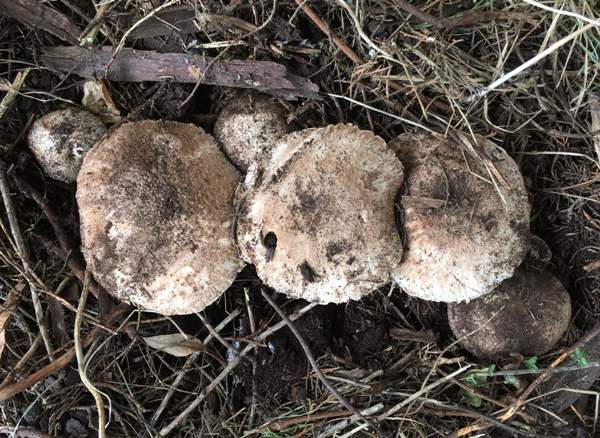
Initially wth a brown pherical cap that
expands to broadly convex with a surface that breaks up into broad brown scales on a pale background, Agaricus subperonatus is one of a group of mainly woodland Agaricus species whose cut flesh turns pink or reddish.
Distribution
An infrequent find in Britain and Ireland, usually in small groups but occasionally solitary, Agaricus subperonatus is widely distributed but generally uncommon throughout northern and central Europe. This mushroom occurs also in parts of western North America.
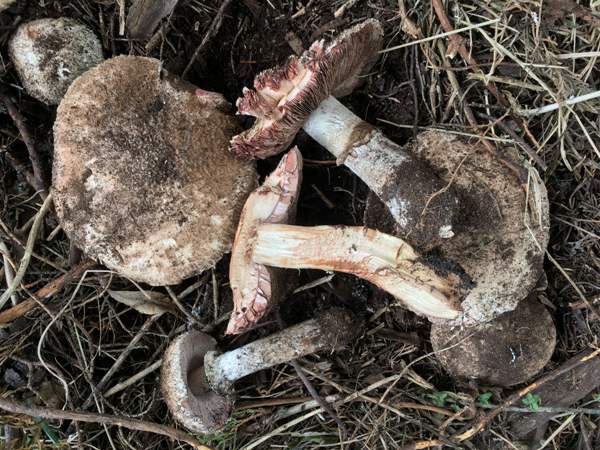
Taxonomic history
This mushroom was first described scientifically in 1926 by Dutch mycologist Jakob Emanuel Lange, who initially considered it merely as a form of Psaliota hortensis, when he gave it the name Psalliota hortensis f. subperonata. The currently-accepted scientific name Agaricus subperonatus dates from a 1951 publication by German-American mycologist Rolf Singer.
Synonyms of Agaricus subperonatus include Psalliota hortensis f. subperonata J.E. Lange, Psalliota hortensis var. subperonata J.E. Lange and Psalliota subperonata J.E. Lange.
Agaricus cappellianus Hlaváček, Agaricus vaporarius (Pers.) Imbach, and Agaricus pseudovillaticus Rauschert are also considered by some authorities to be co-specific with Agaricus subperonatus.
Etymology
The specific epithet subperonatus comes from Latin, with sub- meaning under or below, and -peronatus meaning sheathed or booted. I therefore infer that subperonatus means 'wearing a low boot' - a reference to the booted (peronate) appearance of the stem with its substantial ring.
Identification guide
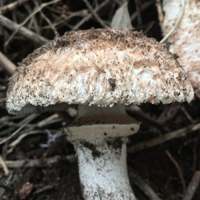 |
Cap
The caps of this mushroom are initially spherical, becoming broadly convex or almost flat at
maturity. Brown at first, as the cap expand its surface breaks into adpressed brown scales on a pale creamy-white background. Cap diameter usually ranges from 6 to 15cm. Cap flesh white then turns pale pink. |
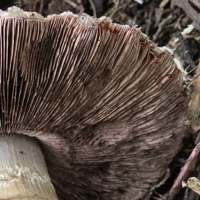 |
Gills
White at first, the crowded free gills turn
greyish pink and then dark brown as the spores mature.
Stem
Whitish, smooth cylindrical or slightly clavate, 5 to 12cm tall and 1.5 to 3cm in diameter
with a pointed baseunivrsal veil forms a volva-like boot below a superior or median stem ring, which is triangular in cross section. Lower stem and ring edge often flecked with brown partial veil fragments. Stem flesh initially white turning pink or reddish esp. near stem base. |
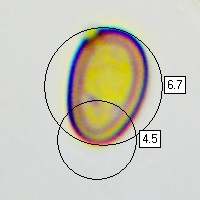 |
Spores
Ellipsoidal to ovoid, smooth, 5.5-7.5 x 4.8-6µm.
Spore print
Chocolate brown. |
Odour/taste |
Taste not distinctive; odour 'mushroomy', some say becoming more like liquorice when old. |
Habitat & Ecological role |
Agaricus subperonatus is saprobic and often occurs in small groups on tree-shaded, humus-rich disturbed ground including woodland edges, roadside verges, parks and gardens rich in leaf litter; usually in small groups. |
Season |
July to November in Britain and Ireland. |
Similar species |
Agaricus sylvaticus has grey-brown
scales and a floppy stem ring.
Agaricus augustus, The Prince, is larger and smells of bitter almonds. |
Culinary Notes
This uncommon mushroom is reported to be edible but of indifferent or poor culinary quality.
Reference Sources
Fascinated by Fungi, 2nd Edition, Pat O'Reilly 2016, reprinted by Coch-y-bonddu Books in 2022.
BMS List of English Names for Fungi
The genus Agaricus in Britain, 3rd Edition, self-published, Geoffrey Kibby 2011
Funga Nordica: 2nd edition 2012. Edited by Knudsen, H. & Vesterholt, J. ISBN 9788798396130
Dictionary of the Fungi; Paul M. Kirk, Paul F. Cannon, David W. Minter and J. A. Stalpers; CABI, 2008
Taxonomic history and synonym information on these pages is drawn from many sources but in particular from the British Mycological Society's GB Checklist of Fungi.
Acknowledgement
This page includes pictures kindly contributed by Simon Harding.
Top of page...
Fascinated by Fungi. Back by popular demand, Pat O'Reilly's best-selling 450-page hardback book is available now. The latest second edition was republished with a sparkling new cover design in September 2022 by Coch-y-Bonddu Books. Full details and copies are available from the publisher's online bookshop...